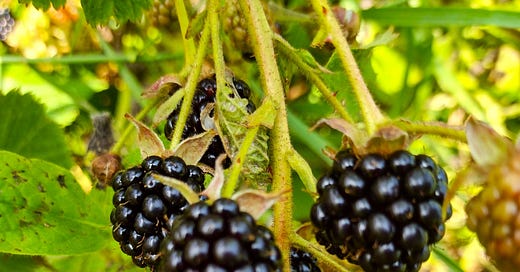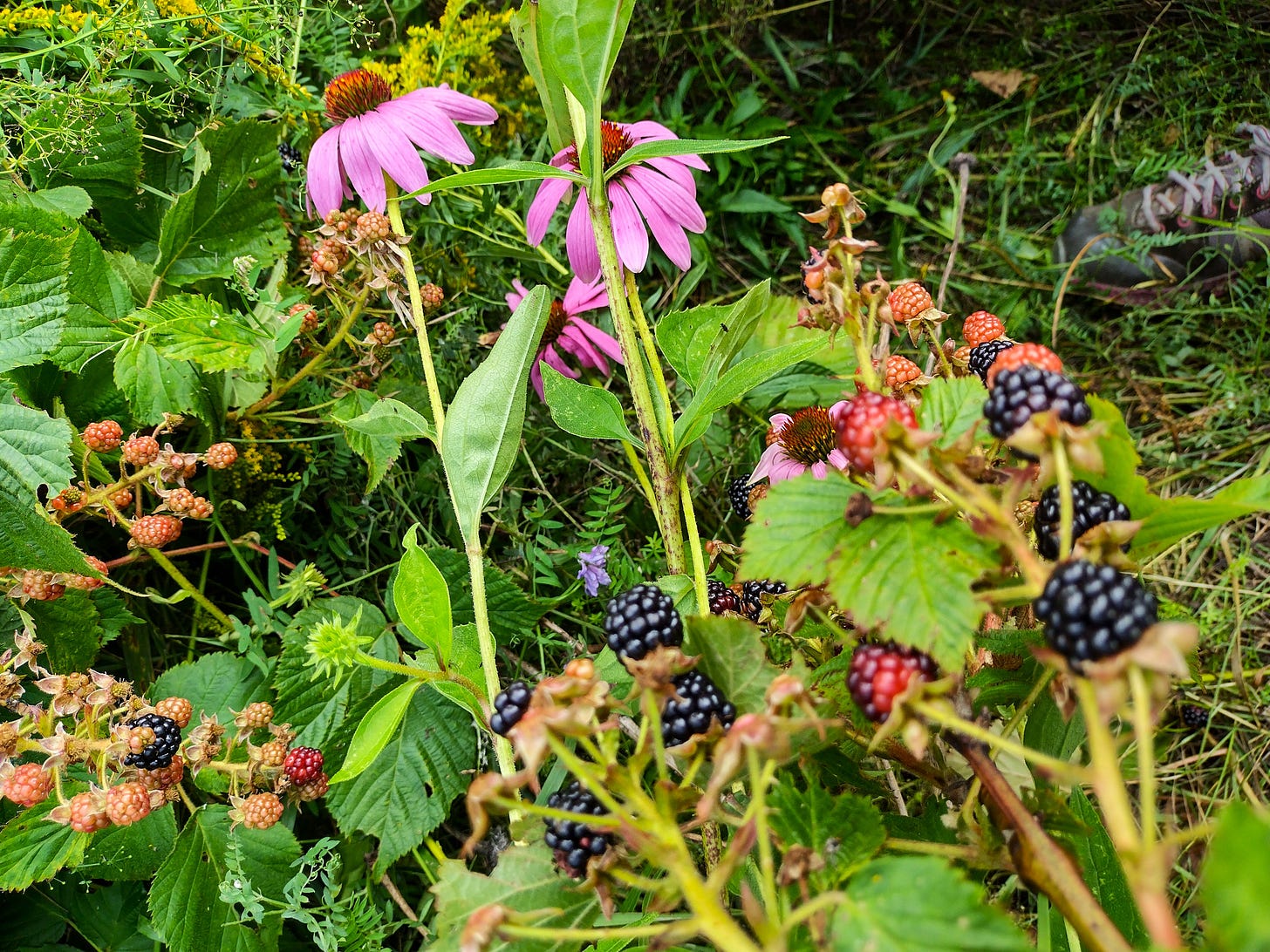It is beyond 30 degrees Celsius, with a humidex making it feel like some ungodly number I don’t even want to contemplate. Instead of sensibly wearing as little clothing as possible, I am dressed in my thick coveralls. I need this armour to shield me from the dagger-like thorns jabbing me from all angles. Hidden amongst these thorns are little black jewels, the diamonds in the rough I am seeking, tiny rewards for this unique form of self-inflicted punishment.
Genevieve has been in here too, cutting paths with secateurs through the blackberry jungle, dense with canes arching 8 feet past our heads. The most either of us can stand of this is about two hours. Genevieve wraps ice cubes in a cloth and drapes on the back of her neck. We stumble home with beet red faces, on the verge of heatstroke, and stand in the walk-in cooler, letting the sweet cold air blow over our bodies.
What drives us is some combination of not wanting to squander previous investments in time and money in the establishment of this bramble patch, an aversion to seeing good food go to waste, and the fact that, once paths are hacked, we can pick $40 - $50 worth of berries an hour – a very good wage by farming standards.
But picking these berries in the burning hot sun, dressed as we must be (and still getting the odd poke through our cotton garments, plus many in our naked hands), really makes us question our choice of profession. Referring to our one employee, who is coming back from holidays next week, Genevieve says, “DO NOT send Cameron in here to pick all day by himself. He will quit.” She’s right.
These blackberries – devilberries might be more apt – also make me question my choice to plant them in the first place. In BC, they are often considered a weed, growing into towering barbed wire matrices that could have provided good fortification for a medieval town. People harvest them by setting ladders up against them and picking through the slats. In our part of the world, there is a wild species, but it is rare. For most of this branch of the Rubus genus, our winters are too cold. But when we were establishing our permaculture orchard (see my previous article about this), I saw in the Quebec small fruit nursery catalogue a blackberry called simply “Hardy Black”, supposed to be able to withstand our zone 4 climate, and ordered a bunch. We planted every second row with them.
In the decade since that fateful decision, most of what we also planted has died out, but the blackberries have filled the void. I used to mow with the tractor the paths between the rows, but at a certain point I gave up. This was partly because I planted them on a hillside, which made mowing a nerve-wracking dance with a possible roll-over, but also because of the fickle nature of this berry-of-the-black.
Blackberries, I discovered, like to mess with you. I guess this should come as no surprise for a plant that simultaneously offers up delicious sweet fruit and lacerating thorns. (Perhaps you know people like this.) Another feature of our particular patch is that we would often watch as what looked like a large crop of berries would gradually start to ripen, from green to red, but then something would happen to them before they swelled to their full dark black ripeness. We suspect birds and raccoons, who seem to have a radar for fruit that is just about to ripen, were making off with them before we could pick. Spurned one too many times, I abandoned all maintenance.
But then last year, the ripening crop did not mysteriously disappear, and we sold a good number of them. And this summer, with its abundant rain, our blackberries must have felt like their well-watered west coast cousins, and produced in similar abundant fashion. It was an offer we couldn’t refuse.
Genevieve spearheaded the advance into the thicket; I somewhat reluctantly followed. Then Cameron came back from holidays, and I sent my troop into the fray. He came back battle scarred, but not so demoralized that we risked desertion. Then Genevieve left for holidays, and Cameron got sick, and I was left facing the piercing darts of the barbarous hordes by myself. I dove in, foolishly unarmed without secateurs, into the trackless wilderness. Soon I felt a claustrophobic panic setting in, as the thorns, which seem to have imperceptible hooks built into them, clawed at me from all directions. I beat a hasty retreat, vowing to never again engage this wild spirit without some form of cutting blade by my side.
As I renewed my foray, I thought of the women from Jeju Island, off the coast of Korea, who used to dive in the freezing north Pacific for seafood. If they could do that, day after day, surely I could bear these thorns and this heat. Perhaps somewhat delirious, I also imagined I was a machete wielding explorer, hacking through the jungle, in search of lost treasures.
The season is winding down now, and reinforcements have arrived. Once all the berries have been harvested, I think I will mow those paths again. And maybe I’ll even put the work into pruning the remaining canes in the way that one is supposed to. I have noticed that the berries at the top, exposed to the sun, are sweeter than the ones buried under layers of leaf and cane. If we try to tame this bramble beast just a bit, we should get bigger, sweeter berries, much more easily harvested.
I’m sure the wildlife will appreciate how much easier it is for them to help themselves.






Excellent article !